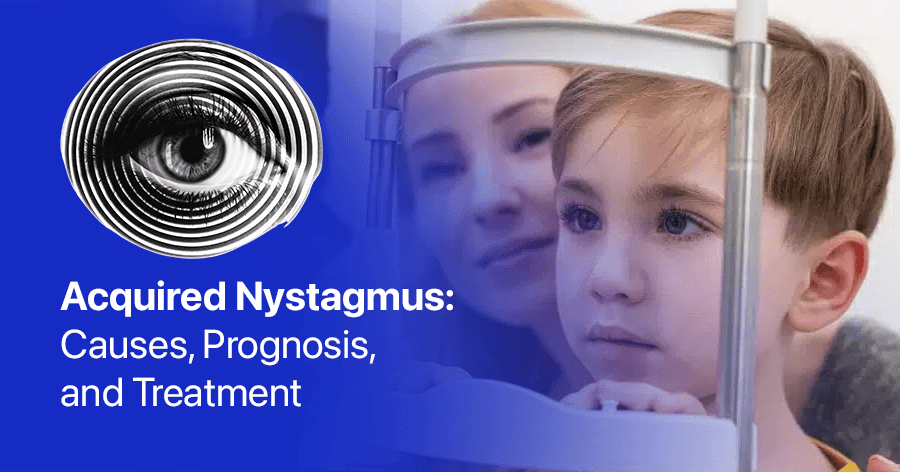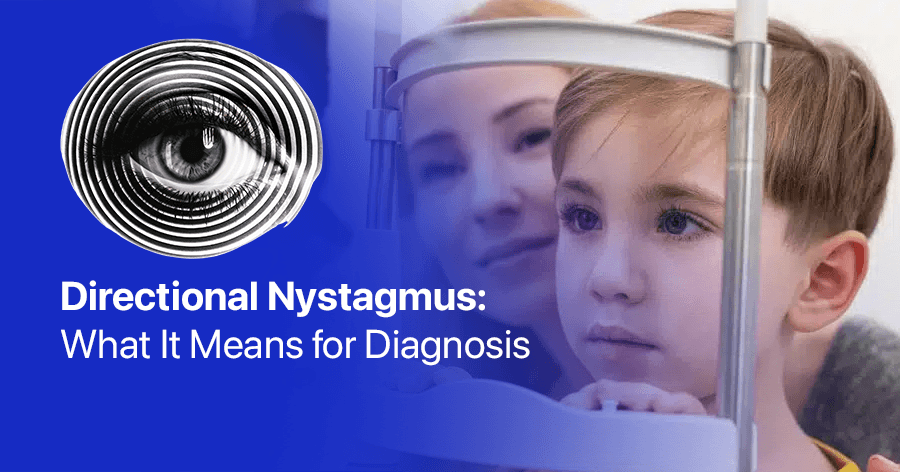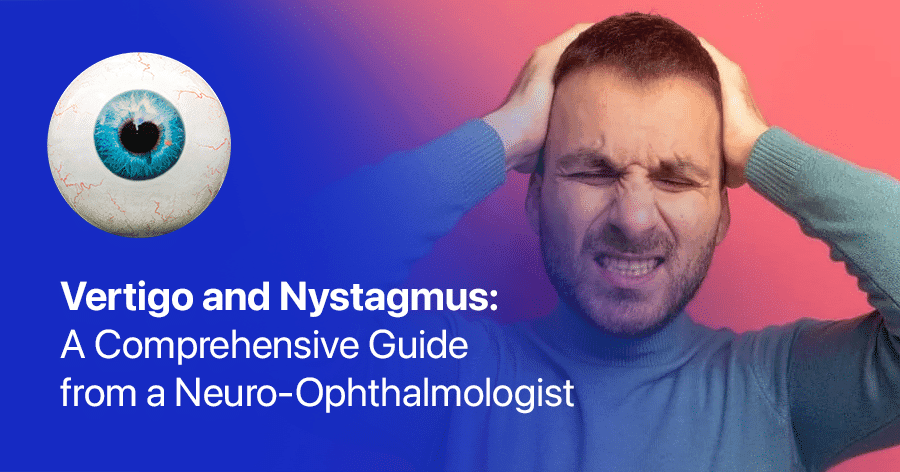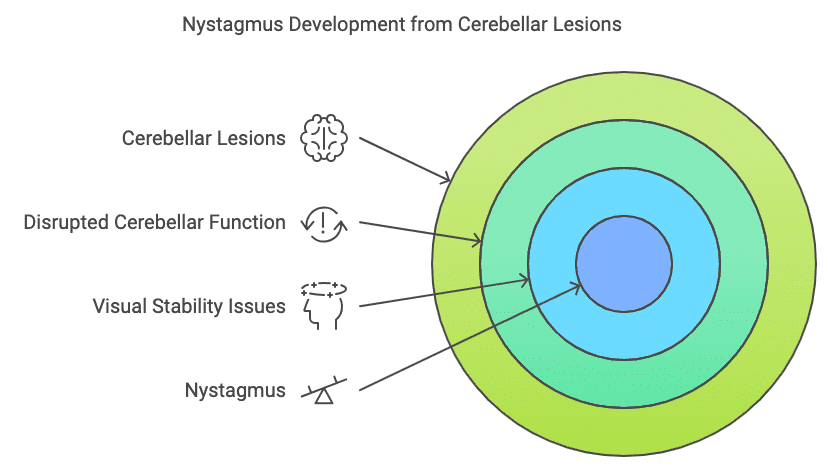
Acquired Nystagmus: Causes, Prognosis, and Treatment
What is Acquired Nystagmus?
Acquired nystagmus occurs when a person develops involuntary eye movements after birth, often as a result of neurological or vestibular system disturbances. Unlike congenital nystagmus, acquired forms can appear suddenly and may be accompanied by other symptoms.As a neuro-ophthalmologist specializing in nystagmus, I’ve encountered numerous cases and understand the challenges patients face. This article aims to provide a comprehensive overview of acquired nystagmus, its types, causes, prognosis, and management strategies.
Common Types of Acquired Nystagmus

1. Vestibular Nystagmus
- Cause: Inner ear disorders or damage to the vestibular system
- Characteristics: Horizontal or rotatory eye movements
- Associated conditions: Vertigo, balance problems
2. Gaze-Evoked Nystagmus
- Cause: Neurological disorders affecting the brainstem or cerebellum
- Characteristics: Occurs when looking to the side, up, or down
- Associated conditions: Multiple sclerosis, stroke, brain tumors
3. Downbeat Nystagmus
- Cause: Lesions in the cerebellum or brainstem
- Characteristics: Eyes drift upward, then quickly move downward
- Associated conditions: Chiari malformation, cerebellar degeneration
4. Pendular Nystagmus
- Cause: Multiple sclerosis or other brainstem disorders
- Characteristics: Eyes move back and forth with equal velocity
- Associated conditions: Optic nerve or visual pathway damage
5. Drug-Induced Nystagmus
- Cause: Certain medications or substance abuse
- Characteristics: Varies depending on the substance
- Associated conditions: Anticonvulsant toxicity, alcohol intoxication
Will Acquired Nystagmus Go Away? Understanding the Prognosis
One of the most common questions patients ask is whether their acquired nystagmus will resolve on its own. The prognosis for acquired nystagmus varies significantly depending on the underlying cause and the individual’s overall health. Some key points to consider:
- Temporary cases: In some instances, such as those caused by certain medications or alcohol consumption, acquired nystagmus may resolve once the triggering factor is removed.
- Treatable underlying conditions: When nystagmus is secondary to a treatable condition like vitamin B12 deficiency or multiple sclerosis, addressing the primary issue may lead to improvement or resolution of the nystagmus.
- Chronic cases: Unfortunately, some forms of acquired nystagmus, particularly those resulting from structural brain damage, may be permanent.
- Adaptation: Even in cases where the nystagmus persists, the brain can often adapt over time, leading to improved visual function and reduced symptoms.
It’s crucial to work closely with a neuro-ophthalmologist to determine the specific prognosis and develop an appropriate management plan.
What causes Acquired Nystagmus?
Acquired nystagmus can stem from various factors affecting the brain and nervous system. Understanding these causes is essential for accurate diagnosis and treatment. Some of the most common causes include:
- Neurological disorders:
- Multiple sclerosis
- Brain tumors
- Stroke
- Traumatic brain injury
- Vestibular system issues:
- Benign paroxysmal positional vertigo (BPPV)
- Vestibular neuritis
- Ménière’s disease
- Toxicity and deficiencies:
- Alcohol or drug intoxication
- Vitamin B12 deficiency
- Thiamine (vitamin B1) deficiency
- Medications:
- Anticonvulsants
- Sedatives
- Lithium
- Other causes:
- Wernicke’s encephalopathy
- Cerebellar disorders
- Optic nerve or visual pathway abnormalities
Identifying the underlying cause is crucial for developing an effective treatment strategy and understanding the long-term prognosis.
Can acquired nystagmus be cured
The answer is Yes, but what you should know is that managing acquired nystagmus often involves a multidisciplinary approach, combining medical interventions with supportive therapies. Treatment options may include:
- Addressing the underlying cause:
- Treating neurological conditions
- Correcting vitamin deficiencies
- Modifying or discontinuing problematic medications
- Medications:
- Gabapentin
- Baclofen
- Memantine
- Clonazepam
- Optical devices:
- Prism glasses
- Contact lenses with artificial irises
- Surgical interventions:
- Extraocular muscle surgery (in select cases)
- Deep brain stimulation (for severe, refractory cases)
- Vestibular rehabilitation:
- Balance training exercises
- Gaze stabilization techniques
- Vision therapy:
- Eye movement exercises
- Visual perception training
The choice of treatment depends on the specific type of nystagmus, its underlying cause, and the individual patient’s needs and preferences.
Coping Strategies and Support
While managing the medical aspects of acquired nystagmus is crucial, it’s equally important to address the day-to-day challenges patients face. Here are some strategies to help individuals cope with the condition:
- Adaptive techniques:
- Using large-print materials
- Adjusting lighting conditions
- Employing text-to-speech software
- Emotional support:
- Joining support groups
- Seeking counseling or therapy
- Educating family and friends about the condition
- Occupational adjustments:
- Workplace accommodations
- Exploring assistive technologies
- Considering career adaptations if necessary
- Lifestyle modifications:
- Maintaining a healthy diet and exercise routine
- Managing stress through relaxation techniques
- Ensuring adequate sleep and rest
- Regular follow-ups:
- Maintaining ongoing communication with healthcare providers
- Monitoring for changes in symptoms or visual function
By implementing these strategies, individuals with acquired nystagmus can improve their quality of life and maintain independence.
The Role of Neuro-Ophthalmologists in Managing Acquired Nystagmus
As specialists in both neurological and ocular disorders, neuro-ophthalmologists play a crucial role in diagnosing and managing acquired nystagmus. Their expertise is invaluable in:
- Conducting comprehensive evaluations
- Interpreting complex diagnostic tests
- Developing personalized treatment plans
- Coordinating care with other specialists
- Providing ongoing monitoring and support
Regular consultations with a neuro-ophthalmologist ensure that patients receive the most up-to-date and effective care for their condition.
Research and Future Directions in Acquired Nystagmus Treatment
The field of neuro-ophthalmology is constantly evolving, with ongoing research aimed at improving our understanding and treatment of acquired nystagmus. Some promising areas of investigation include:
- Gene therapy for specific forms of nystagmus
- Advanced neuroimaging techniques for better diagnosis
- Novel pharmacological interventions
- Refinement of surgical techniques
- Development of more sophisticated adaptive technologies
Staying informed about these advancements can provide hope and new options for patients struggling with acquired nystagmus.
Stay Informed with “The Nystagmus Book”
If you’re looking to deepen your understanding of nystagmus and stay up-to-date with the latest research and management strategies, I invite you to check out my book, “The Nystagmus Book.” This comprehensive guide contains all the legitimate, up-to-date information about nystagmus as of 2024, including the most recent research findings and best practices for managing the condition.
In a world where misleading information about nystagmus is unfortunately common, “The Nystagmus Book” offers a reliable, science-based resource. It’s packed with practical tips, the latest treatment options, and insights from my 20+ years of research in the field. Whether you’re living with nystagmus, caring for someone who is, or simply want to learn more about this condition, this book is an invaluable resource.




